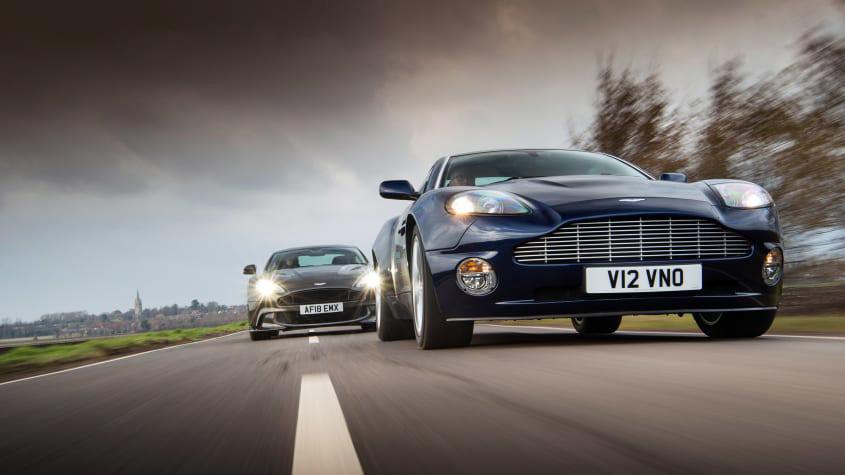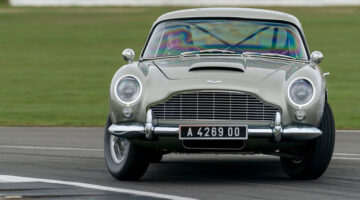The Aston Martin range was topped for nearly 20 years by a Vanquish on the VH platform, so we brought together the first and last examples before a new mid-engined Vanquish arrives
It wasn’t long ago I was muttering about the amount of high-speed wind noise seeping into the Vanquish’s cabin; it sounded like the windscreen was literally thin, rather than a failing seal, and I made some pedantic, road-testery scribble about turn-of-the-millennium NVH standards. Now I’m grinning so hard about it my face hurts.
The road ahead snakes through a motley copse of trees, and Ian Eveleigh has dropped the hammer in the Vanquish S, whereupon all of its near-600bhp is roaring, spitting and crackling its way through the air, permeating the glass in front of my nose and ringing in my ears as if I’m sitting on the newer car’s carbonfibre bootlid. Then, like the slider gliding forwards on a studio mixing desk, the soundtrack is increasingly augmented by ‘my’ V12 ahead of the bulkhead in front of me, the whine of the valve gear complemented by the idiosyncratic wind-band blare that denotes this long-serving unit as the crank speed rises higher and it finds its quieter, but no-less-melodic voice. We’re in a fast-moving, 24-cylinder convoy, part majestic, part a little bit naughty. In my mind, everything Aston Martin should always be.
The Vanquish. The flagship. The ultimate Aston Martin. A great name: suggests winning but with a caddish cherry on top. It’s a lineage that stretches from the turn of the millennium to just last year, and as you’ll know if you read your magazines how we plan them, the badge is returning, this time on an outrageous, mid-engined Ferrari F8 Tributo rival. That in itself poses an interesting point, because while the name remains, generation three will share nothing with its older relations, not even the V12. The DBS Superleggera is the spiritual successor to the 2017 Vanquish S you see here: a big – and big-hearted – front-engined mixture of GT and supercar, blending luxury with 322kph performance.
Aston Martin is a company with, shall we say, an exciting history – for better and for worse. One such time of tumultuous change was the mid-’90s, when the inevitable switch from creating small numbers of outdated – albeit loveable – hand-built V8 GT cars to being a modern, higher-volume car company became crucial to the firm’s survival. Under Ford ownership the bridge was the DB7, heavily based on the Jaguar XJS and its canned ‘F-type’ replacement, then repurposed by TWR in simpler form as an entry-level, relatively mass-produced Aston Martin. Built in its own factory at Bloxham, just south of Banbury, and away from Aston Martin’s then long-standing home of Newport Pagnell, it saved the company from extinction.
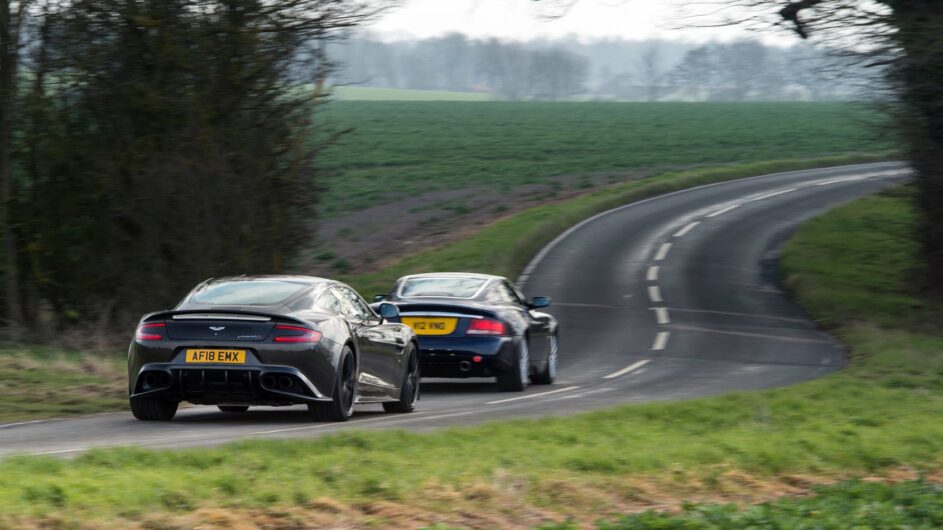
Bolstered by this success, the firm then needed to replace the big Virages and Vantages higher up the range, and the solution was something altogether more sophisticated, very aluminium, and V12 powered. Our first sight of what this might be was a 1998 concept called – somewhat confusingly – Project Vantage. What a stunner it was. Arguably designer Ian Callum’s finest work, it drew heavily on Aston’s historic relationship with Zagato, yet with a subtlety almost completely absent from more recent tie-ups with the styling house. While the new V12 appeared in a DB7 first (the 1999 DB7 Vantage V12), it wasn’t until 2000 that we saw the production car Project Vantage had become, and thankfully much of the concept was carried over intact. Fittingly, given the contents elsewhere in this issue, the official debut of the car came at the Geneva motor show, some 18 years ago.
It was a new name, an (almost) new engine, and a new platform too, because the original Vanquish was the first Aston to use what would become the trusty riveted and bonded aluminium ‘VH architecture’ (that’s Vertical/Horizontal, a reference to not only its adaptability within the Aston Martin product portfolio, but also across the other luxury brands in the ill-fated, Ford-owned Premier Automotive Group). Soon there was a new family of VH-platform Astons, but these were the cars from Gaydon, and the Vanquish always had a slightly odd relationship with them – sharing technology, but still virtually hand-built on the old site and not in the suave new facility. The end came in 2007, after 2589 first-generation Vanquishes had been built.
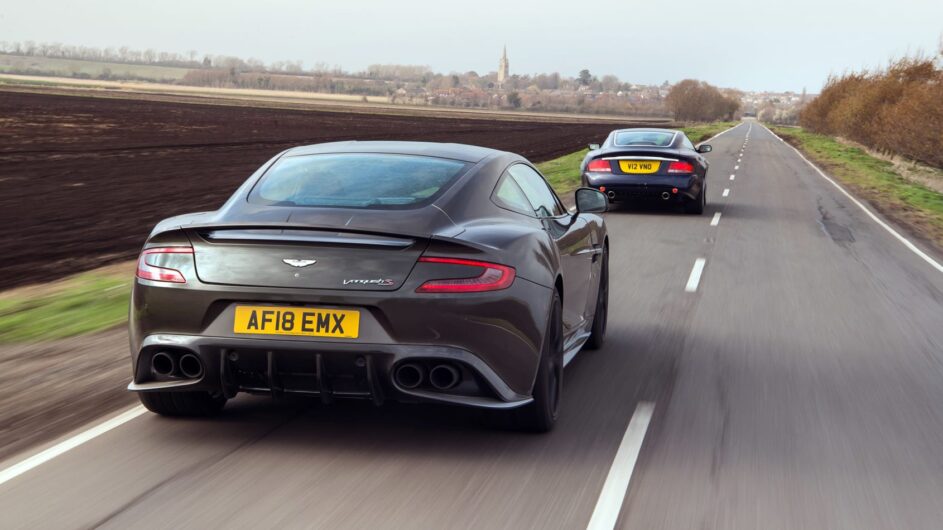
I feel I’ve done quite well to get this far and not yet have mentioned a certain British secret agent and a 2002 film that cemented the Vanquish’s position with the public at large of its true blue Aston Martin status. Standing next to the original today, it’s surprising how the passing of years has mellowed its more aggressive notes, softening its edges and making it seem almost reserved next to the jutting aero devices, glossy carbon and overt aggression of the 2017 car. The really clever thing is it isn’t too beautiful. It has some great angles, yes, but also some rather more unusual bulges of ‘character’, some slightly odd forms that make it more handsome than aesthetically flawless. And much like a traditional Hollywood leading man, it’s the flaws that add gravitas, personality and toughness to the conventional beauty. The original achieves its presence by its inherent form – the lines and surfacing of its aluminium panels. The more conventionally styled yet carbon-clad Vanquish S does so mainly by its sheer proportions and more obvious embellishment.
And what of that other great link between the two, namely the 5.9-litre V12? How many times have you heard the rather chiding remark that this powerhouse is little more than two Ford Duratec V6s spliced together? It does indeed have its roots with the Blue Oval, as Ford and Cosworth designed the engine from the V6 for use in the Ford Indigo concept car, with development for Aston Martin commencing from that point, but really, what does it matter? In the DB7 it made a relatively relaxed 420bhp; in the original Vanquish, as here, it was 460bhp, rising to 520bhp for the S version of 2007 – still some way short of the 595bhp second-generation or ‘AM310’ S also along for this story.
The second-gen Vanquish first appeared in 2012, and while it looked very much like an evolution of the outgoing DBS, it was a thoroughly evolved machine underneath the more rakish panels. Its fourth-generation VH platform was considerably stiffer, and lighter, and the V12 was mounted lower and comprehensively overhauled, with an additional 55bhp over the DBS, meaning 565bhp, not to mention an extra 37lb ft of torque, taking it to 457lb ft.
Available with an automatic ’box only, the original six-speed ZF soon gave way to a much more effective eight-speed unit and a more aggressive chassis set-up in 2014, the 0-100kph time dropping to below four seconds for the first time. In 2017, and with the DB11 already on sale, the Vanquish was upgraded to S specification to distance itself from the new arrival, with a larger intake manifold liberating 595bhp, and joined by a firmer chassis and aero tweaks. Launch control helped the 0-100kph time drop to 3.5sec, while top speed remained at 323kph. This ultimate VH-platform car eventually bowed out last year.
Back to the older car, and there’s one other key thing you need to know about this Mendip Blue 2002 Vanquish, currently for sale at Aston Martin Works in Newport Pagnell, and that’s the presence of the manual gearbox conversion. The only gearbox ever offered with the Vanquish from new was the single-clutch, paddleshift automated manual, and there’s nothing that dates a car quite like these early attempts at a racy automatic ’box. Early Vanquishes developed a reputation for being a little on the high-maintenance side, and much of that was to do with the automated shift set-up, which also requires a specific driving style to avoid drastic clutch wear. However, even while the original Vanquish was still in production the company’s Works Service department was offering the manual conversion: indeed, that’s the last time I drove a Vanquish with three pedals and a stick, and I simply can’t wait to have another go today.
It may be less than 20 years ago that this car first appeared, but after settling into the Vanquish’s cockpit a glance around suggests it could be even longer. The entire centre stack switchgear module is lifted straight from a contemporary Jaguar XJ, while the wheel doesn’t adjust for reach and is subsequently a good stretch away, its primitive and uncomfortable shape denoting the early days of airbags. To be fair, later versions received a much more modern centre console like the one in the then-new DB9. Like so many other manual ’box Aston Martins over recent years, the first few metres of throttle pedal travel don’t seem to offer a great deal, and the clutch pedal travel is also quite a long arc, so it can take a while to smoothly operate the Vanquish at low speed. Similarly, the manual shift isn’t the quickest, and a rap of the knuckles from the centre console is a very real prospect when selecting third unless you’re economical with your movements, betraying the ‘conversion’ aspect of the lever’s presence: you can tell this cabin was never designed to be in a manual car. But you adapt, and soon simply revel in the joy of controlling 12 cylinders with a manual transmission, something impossible to experience on the new car market these days.
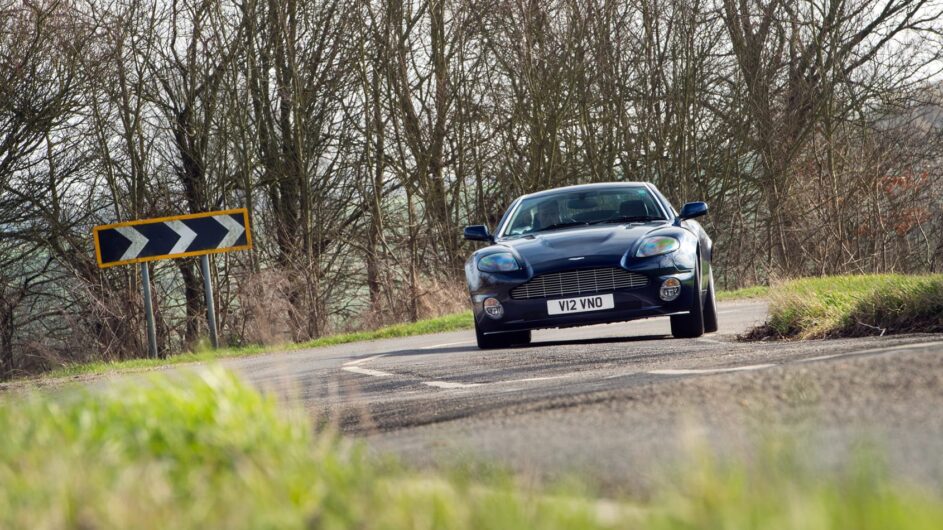
Naturally, the Vanquish doesn’t have the hyperspeed performance of a car of this type in 2019, and yet never do I feel bothered by making slightly slower progress. It is fast enough, in a way your current year-old smartphone doesn’t really need to be replaced, and without a gazillion turbocharged pounds feet of torque you can use more of the V12, more often, which is an entirely good thing. Switching into the newer car it is frenzied in its power delivery by comparison, which is a great initial thrill, but not of massive consequence over a longer-term relationship.
Both cars drive in a broadly similar manner, which is hardly surprising given their shared DNA: quick steering that disguises their weight, a broad, flat feel on the road, and an obvious rear-drive balance. Except everything the older car does, it does so much more slowly, with notably less precision. Seventeen years and 32,000 kilometres make a difference in themselves, sure, but it’s a much less direct sort of car; you have to work with the weight transfer, feed it into corners, feel it settle into a steady cornering state before you can trust to squeeze the throttle open and let the V12 pile on some revs. Do so and you’re treated to that unique cam gear whine of the V12: a rising and falling sizzle that’s pure mechanical extravagance. The great moments in the Vanquish are when everything is working in sync. It can feel a bit clumsy around town, and the driving position is awkward enough for me that I never feel comfortable pushing it on a B-road, but on broad sweepers it’s an incredibly emotive driving experience. It’s the sort of car that needs to be driven to a remote castle; popping to the shops for milk just doesn’t do it justice. And to think you can get a Vanquish for under £60k (even if this car is up for twice that). I know Vanquishes can be searingly expensive to run, and restore if needs be, but still, it’s a deeply appealing prospect.
A start-up flare of revs, those sculptured venturi tunnels at the rear, the bizarre spider web interior stitching – yes, the second-gen car is all very shouty, which I suppose reflects changes to society in recent decades, but if this sounds like the beginning of an ‘old is best’ onslaught then that’s not what I’m meaning to imply. The Vanquish S may have been maturing into old age when it finally left production, but it looks and drives very well on it, and its desirability in no way reflects its advancing years. After the rather faded glory of the original’s interior – just look at those Olde English dials – the 310’s is much more familiar, albeit still aged by its small flip-up infotainment screen. The low-slung driving position and black interior make it feel very snug inside, which some may find claustrophobic, but which immediately makes me want to point the nose for the Continent. You’re left in no doubt that the car around you is a large, long-nosed GT that can pierce the air at over 322kph.
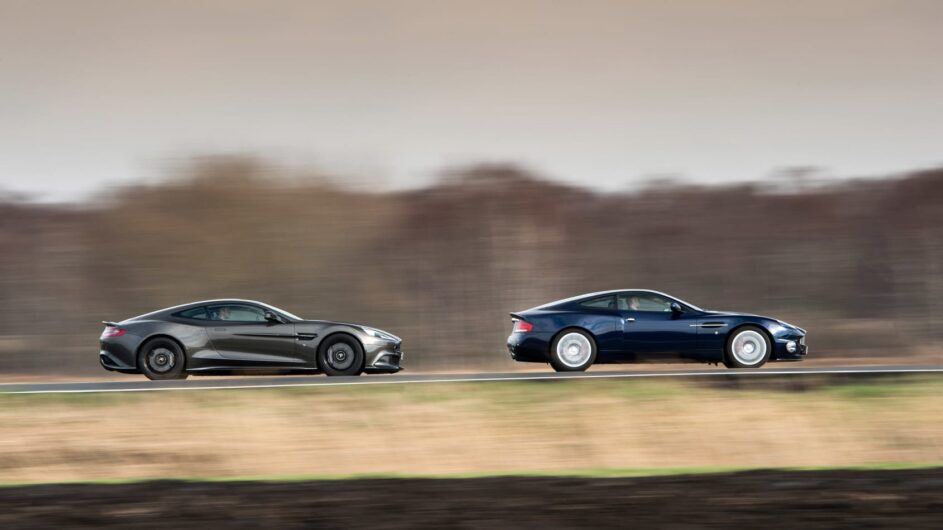
The Vanquish S makes the fairly laid-back first-gen car seem amusingly quaint, delivering not only a far greater punch in a straight line, but also braking, turning and then cornering with genuine enthusiasm and confidence-inspiring precision. Misbehaviour with the rear axle is only a hefty prod of the throttle away and it’s not overly intimidating, even if I’ve never really understood the benefit of the quartic steering wheel.
It’s hard to fault the workings of the eight-speed torque-converter automatic, particularly the way it blends ease of use when left in fully auto mode with the speed and crispness of its shifts when using the paddles manually. But yes, naturally, after the appeal of the manual Vanquish there does seem to be something missing; not just an extra pedal and lever, but an emotional connection to that venerable V12 up ahead.
We track at pace across the English Fens, and it’s instructive to follow the old car. It appears high off the road, and surprisingly narrow tracked, its tasteful 19-inch alloys tucked into its swollen bodywork. It’s so effortlessly easy to keep up in the newer car. Despite the S modifications it can still be a big, comfortable GT when required, but also a car that relishes being driven hard, with fabulous steering and great body control. It’s a revelation to drive one again and a reminder that it’s not the numbers that are important, but the way the recipe is cooked.
Most of all, this pair are a wonderful celebration of the naturally aspirated Aston Martin V12. Valkyrie family aside, we’ll not see their like again, and while the turbocharged V6 in the new Vanquish will undoubtedly do the numbers, and suit the different sort of car that it will be, there’ll always be a place in our hearts – and ears – for this era of big Aston GT cars.
This article originally appeared at evo.co.uk
Copyright © evo UK, Dennis Publishing

